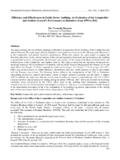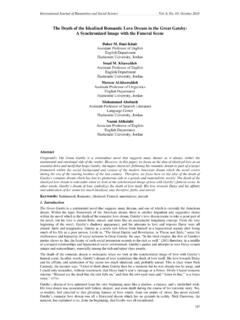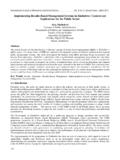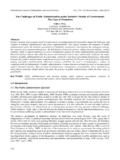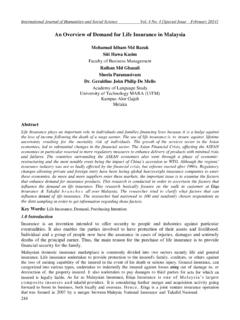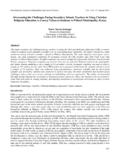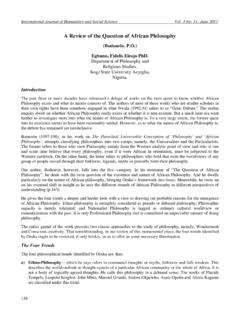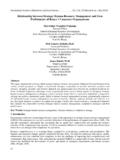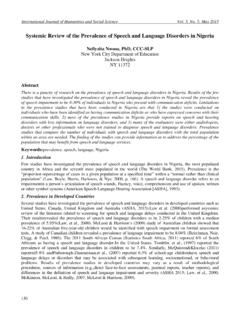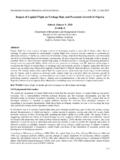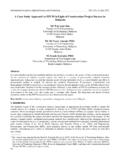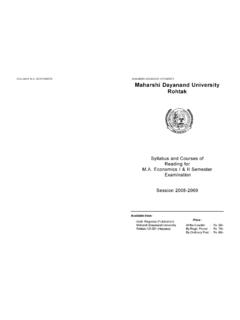Transcription of The Implications of Parametric and Non-Parametric ...
1 International Journal of Humanities and Social Science Vol. 5, No. 6; June 2015 74 The Implications of Parametric and Non-Parametric Statistics in Data Analysis in Marketing Research Dr. Egboro Felix O. Department of Business Administration And Management Delta State Polytechnic Otefe-Oghara, Nigeria Abstract Statistical needs of science, technology and governments had grown. Reviewers of research reports, frequently criticize the choice of statistical methods. Researchers ought to have a large suite of statistical techniques to be successful in analyzing data. Analysis can be viewed as the categorization, the aggregation into constituent parts, and manipulation of data to obtain answers to the research questions or questions underlying the research project. A special aspect of analysis is interpretation, which involve taking the results of analysis and making inferences relevant to the research relationship studied, and drawing managerially useful conclusions about these relationships.
2 In a typical research work, there might be statistical errors and short comings due to the incorrect use of statistical test thereby leading to incorrect conclusions. These incorrect conclusions may have negative effect on the reliability, validity and verifiability of the research results. The focus of this paper is on the nature of data and the correct statistical techniques in relation to Parametric and Non-Parametric statistics that amount to reliable and valid research results. Recommendations were made as per the best inferential statistics that lead to reliable business/marketing decisions, putting into consideration the Implications of robustness Keywords: Parametric Statistics, Research Results, Inferential Statistics, Data Analysis, Robustness Introduction Statistics is the scientific process of collection, organization, analysis and interpretation of data with a view to providing useful concise information for decision making.
3 The use of statistical techniques in marketing research has created concern for many years. Statisticians have long expressed concern about the slow adoption of statistical ideas by researchers and the frequent misuse of statistics when statistical methods were used (Garfield, 1995). According to Egbule (2001), Statistics serves as a means for reducing large volumes of data to manageable and comprehensible form; it is used for the study of population and samples; acts as a suitable means of making decisions on data collected and analyzed and also helps in the process of making reliable inferences from observed data. Nachmias and Nachmias (2009) stated that there are basically two types of statistics which include descriptive and inferential statistics. Descriptive statistics enable the researcher to summarize and organize data in an effective and meaningful way. It involves the use of tables, charts, graphs, mean, modes, median, standard scores and correlation to treat collected data.
4 Inferential statistics is concerned with making inferences from a unit of a population. Inferential statistics allow the researcher to make decisions or inferences by interpreting data patterns. Researchers use inferential statistics to determine whether an expected pattern designated by the theory and hypotheses is actually found in the observations. We might hypothesize that quality product lead to increase in demand. To decide whether this hypothesis is true, we might survey consumers of the same products with different quality. We would then use descriptive statistics to make comparison between these groups and we would employ inferential statistics to determine whether the differences between the groups consumer support our expectations. ISSN 2220-8488 (Print), 2221-0989 (Online) Center for Promoting Ideas, USA 75 Statement of the Problems In a typical research work, there might be statistical errors and short comings due to incorrect use of statistical test thereby leading to wrong conclusions.
5 These incorrect usage of statistics and wrong conclusions may have negative effect on the reliability of the result. Wrong research result can mislead an individual, organization and even a whole nation. This is due to the fact that research is a systematic investigation into problems in order to find solution to them. It involves collection, analysis and interpretation of data. It also involves formulation of hypotheses and subjecting these hypotheses into statistical test. The subjection of these hypotheses into statistical test involves the use of inferential statistics which is an embodiment of Parametric and Non-Parametric statistics. Except the right statistical technique is used on a right data, the research result might not be valid and reliable. Kim (2006) reasoned that as the technology for conducting basic research continues to evolve, further analytical challenges could be expected. In addition the increasing trends on the use of statistical methods would have an impact on how current and future investigators were trained to successfully conduct research.
6 He suggested that the increasing complexity of methods used in research would make it more difficult for investigators to effectively conduct their own research. Strask, et al (2007) identified some common statistical errors and shortcomings that can be observed in a typical research work, which among others include: Incorrect use of statistical test. Failure to adjust for multiple comparisons. Failure to define and explain the statistical test used. Failure to conduct a priori sample size estimation Robustness of statistical techniques. Strasak et al (2007) argued that errors in research can lead to incorrect conclusions. These conclusions had a considerable negative effect on the scientific impact of a research project by diminishing the reliability, validity and the verifiability of the study results. Objectives of the Research To examine the implication of Parametric and non Parametric statistics on reliability of research results.
7 To examine the relevance of robustness on research results. Review of Literature List and Description of Statistical Techniques Ndou (2011) emphasized on different types of statistical techniques of which one has no statistical component. The purpose of this explanation is to acquaint researchers the different types of statistical techniques and the rate at which they are been used, as indicated in table 1. International Journal of Humanities and Social Science Vol. 5, No. 6; June 2015 76 Table I Column Number Category Brief Description 1. No statistics No tabulated data, does not include any of the methods defined in the other categories 2. Basic descriptive statistics Descriptive statistics only percentage estimates, central tendency estimates, dispersion estimates, bar graphs, pie charts, etc. 3. Basic Parametric inferential statistics. Confidence intervals, t-test (one, two independent samples and paired samples).
8 4. Correlation Classical product moment correlation to measure the strength and significance of relationships ( Parametric and non Parametric ). 5. Contingency tables Two way tables (counts and / or percentages). Chi-square tests, Fischer s exact test, McNemar s test. Multi-way summaries (counts and or percentages), Mantel-Haenszel procedure, etc. 6. General Non-Parametric tests. Sign test, Wilcoxon, Kruskal-Wallis and Mann- Whitney test. 7. Dimension reducing techniques Principal component analysis, factor analysis, discriminant analysis, multidimensional scaling, structural equation modeling correspondence analysis, etc. 8. Regression methods Simple, Multiple, Partial, Logistic and Stepwise regression. 9. ANOVA One - way, two - way, and higher order models. 10. Multiple comparisons All statistical procedures for handling multiple inferences on same data sets Benferroni, Scheffe, Duncan, etc. 11. Time series techniques. Autoregressive models, Moving average models (MA) and Autoregressive and Integrated Moving Average (ARIMA) model, (Trend and seasonality analysis, Box & Jenkins and autocorrelations.)
9 12. Simulation Re-sampling techniques, bootstrapping, Jack-knife, all Monte Carlo simulations, etc. 13. Optimization Linear and non linear programming, game theory, network analysis. 14. Advanced newer techniques Designed experiments, repeated measures, missing data methods, power analysis, Source: Aifheli, Amos Ndou (2011) assessing the statistical methodologies of Business Research in South African. The first category does not use any statistical component. The research papers included in this category generally is of a theoretical nature, a literature review or a qualitative assessment. The second category is a basic descriptive statistics used for describing sets of measurements. They are used to summarize and describe the important characteristics of a set of measurements. pie charts, bar graphs, frequency histograms. The inferential statistical method which is the third category is used to make inferences about population characteristics, from information contained in a sample drawn from a population.
10 The coefficient of correlation is used to measure the degree of the association between bivariate variables. When a researcher is interested in measuring two variables on a single experimental unit, the resulting data becomes bivariate data. The two most popular correlation coefficients considered and classified in this category are Spearman s correlation coefficient, and Pearson s product moment correlation coefficients. The coefficient of correlation is a single number that indicates the strength and direction of the relationship between two variables. The value lies in the range - 1 r 1. The fifth category labeled contingency table classified all statistical techniques which analyzes table or counts. Contingency tables generally included measurements that would be considered qualitative or categorical. For example, in a two-dimensional contingency table, two variables may be identified; one variable would determine the row categories and the other would define the column categories.
